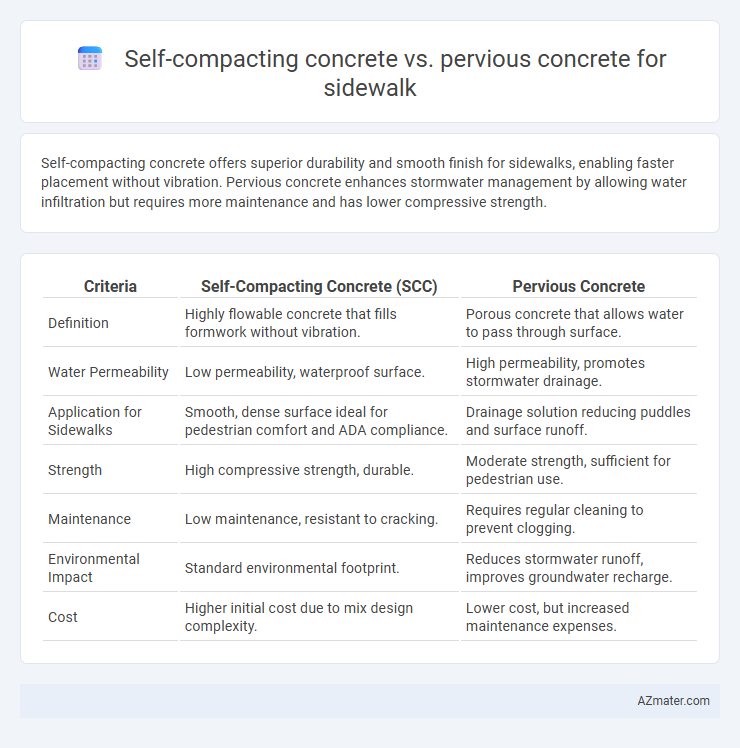Self-compacting concrete offers superior durability and smooth finish for sidewalks, enabling faster placement without vibration. Pervious concrete enhances stormwater management by allowing water infiltration but requires more maintenance and has lower compressive strength.
Table of Comparison
| Criteria | Self-Compacting Concrete (SCC) | Pervious Concrete |
|---|---|---|
| Definition | Highly flowable concrete that fills formwork without vibration. | Porous concrete that allows water to pass through surface. |
| Water Permeability | Low permeability, waterproof surface. | High permeability, promotes stormwater drainage. |
| Application for Sidewalks | Smooth, dense surface ideal for pedestrian comfort and ADA compliance. | Drainage solution reducing puddles and surface runoff. |
| Strength | High compressive strength, durable. | Moderate strength, sufficient for pedestrian use. |
| Maintenance | Low maintenance, resistant to cracking. | Requires regular cleaning to prevent clogging. |
| Environmental Impact | Standard environmental footprint. | Reduces stormwater runoff, improves groundwater recharge. |
| Cost | Higher initial cost due to mix design complexity. | Lower cost, but increased maintenance expenses. |
Introduction to Concrete Innovations in Sidewalk Construction
Self-compacting concrete (SCC) and pervious concrete represent advanced materials revolutionizing sidewalk construction by enhancing durability and environmental sustainability. SCC offers superior flowability without segregation, reducing labor costs and improving surface finish, while pervious concrete facilitates stormwater drainage through its porous structure, mitigating urban flooding. These innovative concretes address contemporary urban challenges by combining structural integrity with ecological benefits, making them ideal choices for modern pedestrian infrastructure.
What is Self-Compacting Concrete?
Self-compacting concrete (SCC) is a highly flowable, non-segregating concrete mixture designed to spread into place, fill formwork, and encapsulate reinforcement without mechanical vibration. Its unique rheological properties ensure uniformity, reduce labor costs, and enhance surface finish, making it ideal for intricate sidewalk designs. Compared to pervious concrete, SCC offers superior strength and durability but has lower permeability, affecting water drainage on sidewalks.
Characteristics of Pervious Concrete
Pervious concrete is highly permeable, allowing water to pass through its porous structure, reducing runoff and promoting groundwater recharge around sidewalks. Its open-graded aggregate and lower cement content result in a lightweight concrete with high air void content, typically ranging from 15% to 25%. This characteristic makes pervious concrete ideal for sustainable urban drainage systems but may require careful maintenance to prevent clogging and retain permeability over time.
Workability and Placement Techniques
Self-compacting concrete offers superior workability due to its high flowability, eliminating the need for mechanical vibration during placement, which ensures uniform compaction especially in intricate sidewalk molds. Pervious concrete requires careful control of aggregate grading and minimal fines to maintain porosity, necessitating specialized placement techniques such as rodding or light screeding to prevent clogging while preserving its permeability. Both concretes demand precise mix design and skilled handling, but self-compacting concrete simplifies placement in constrained areas, whereas pervious concrete prioritizes drainage efficiency through its open-graded structure.
Durability and Longevity Comparison
Self-compacting concrete (SCC) offers superior durability for sidewalks due to its high density and homogeneous composition, minimizing permeability and reducing susceptibility to freeze-thaw cycles and chemical attack. Pervious concrete enhances water drainage and reduces hydroplaning risks but exhibits lower compressive strength and greater vulnerability to clogging and surface wear over time. The longevity of SCC sidewalks generally surpasses that of pervious concrete, making it a preferred choice in high-traffic urban environments requiring robust structural performance.
Permeability and Drainage Performance
Self-compacting concrete (SCC) offers superior workability and dense matrix with very low permeability, making it less effective for drainage performance in sidewalks compared to pervious concrete. Pervious concrete is engineered with high porosity, enabling excellent water permeability and rapid drainage, which helps reduce surface runoff and improve stormwater management on pedestrian pathways. Selecting pervious concrete enhances sidewalk durability while promoting sustainable urban drainage systems through effective water infiltration.
Strength and Structural Integrity
Self-compacting concrete offers superior compressive strength, typically ranging from 30 to 50 MPa, ensuring enhanced structural integrity for sidewalks under heavy pedestrian and occasional vehicular loads. Pervious concrete, designed for high permeability, generally exhibits lower strength around 10 to 20 MPa, making it suitable for low-traffic areas while promoting stormwater infiltration. The choice between the two depends on the required balance between load-bearing capacity and environmental permeability in sidewalk applications.
Maintenance and Repair Considerations
Self-compacting concrete requires less frequent repairs due to its dense, uniform structure that resists cracking and reduces permeability, minimizing water-induced damage on sidewalks. Pervious concrete, designed for drainage, demands regular maintenance to prevent clogging from debris and sediment, which can impair its permeability and compromise structural integrity. Long-term upkeep costs for self-compacting concrete tend to be lower, while pervious concrete needs proactive cleaning measures to maintain effectiveness and prevent costly repairs.
Environmental Impact and Sustainability
Self-compacting concrete offers reduced waste and lower energy consumption due to its efficient placement and reduced need for vibration, enhancing sustainability in sidewalk construction. Pervious concrete promotes groundwater recharge and reduces stormwater runoff, significantly mitigating urban flooding and improving water quality. While self-compacting concrete excels in minimizing resource use during installation, pervious concrete provides long-term environmental benefits through improved permeability and ecosystem support.
Cost-Effectiveness for Sidewalk Projects
Self-compacting concrete offers higher initial costs due to specialized mix design and admixtures but reduces labor expenses through faster placement and minimal vibration needs, making it cost-effective for complex sidewalk shapes. Pervious concrete typically has lower material costs but may incur higher maintenance expenses over time due to clogging and durability concerns in high-traffic sidewalk areas. Evaluating long-term lifecycle costs, including installation speed, maintenance frequency, and drainage benefits, is essential for determining the most cost-effective concrete type for sidewalk projects.

Infographic: Self-compacting concrete vs Pervious concrete for Sidewalk
 azmater.com
azmater.com